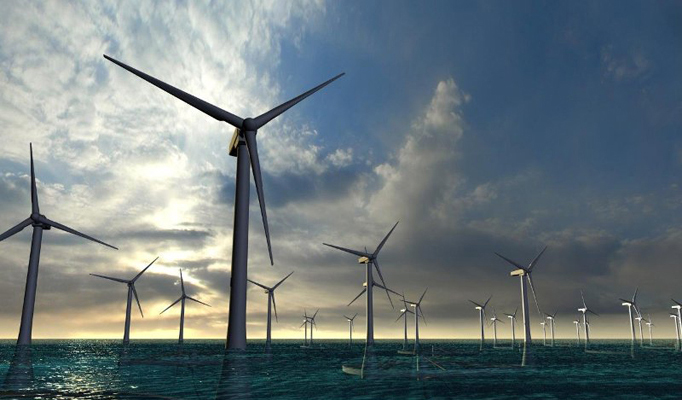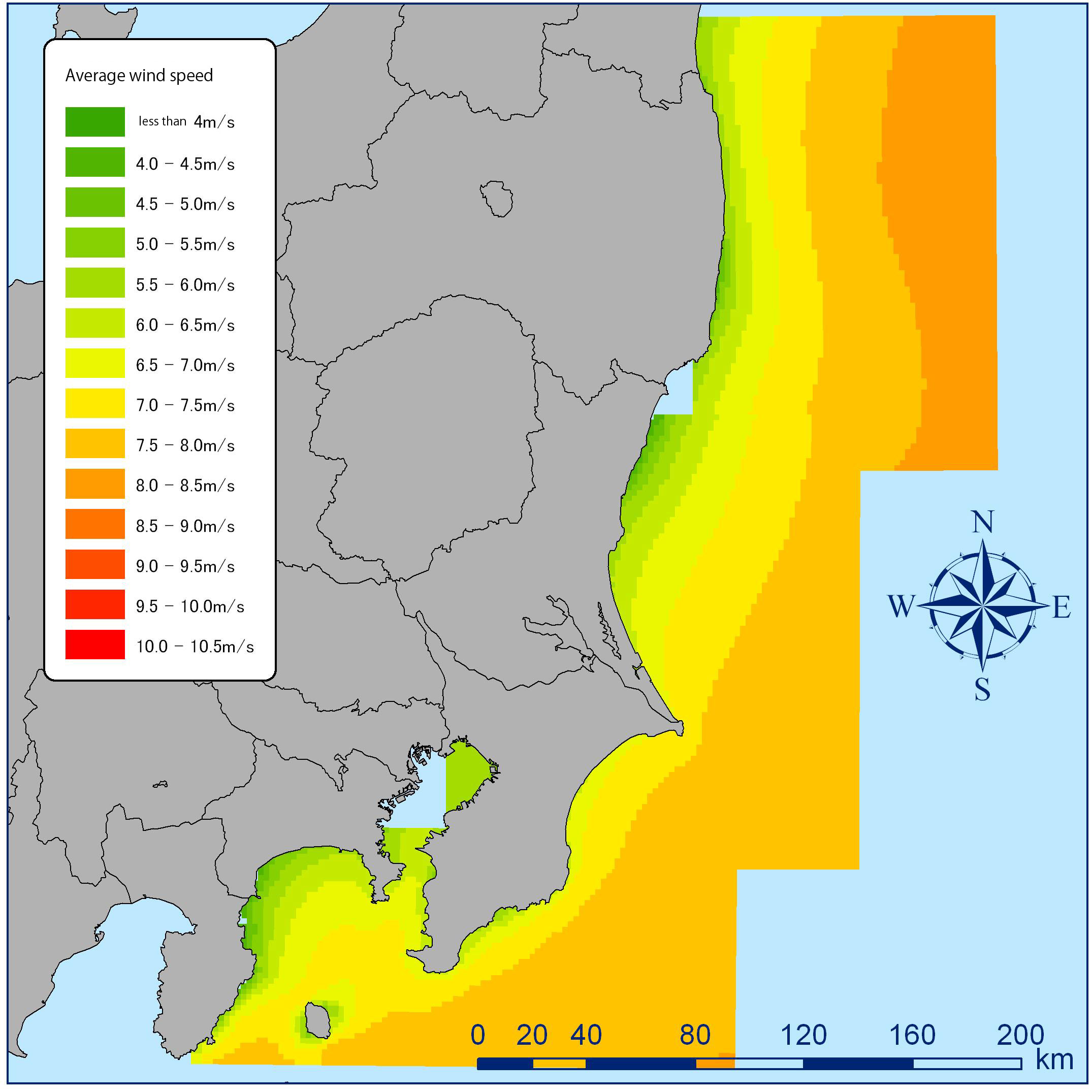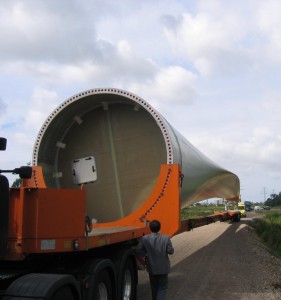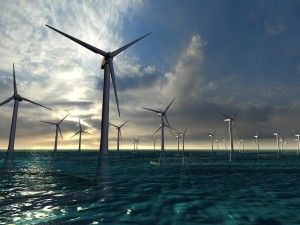Harvesting the Winds of Fukushima Japan to Build World’s First Floating Wind Farm

The University of Tokyo (Todai), together with a group of major Japanese corporations, including Marubeni Corporation, Mitsubishi Corporation, Mitsubishi Heavy Industries, IHI Marine United, Mitsui Engineering & Shipbuilding, Nippon Steel Corporation, Hitachi, Furukawa Electric and Shimizu Corporation, are planning to build a large-scale floating offshore wind farm that will be the largest facility of its kind in the world. The project, based on research started ten years ago at Todai, is part of the Ministry of Economy, Trade and Industry’s effort to boost Japan’s renewable energy resources and revitalize the Tohoku regional economy in the wake of the devastating 11 March 2011 earthquake and tsunami that struck the northeast coast of Japan, and which has led to the shutdown of all the country’s 54 nuclear reactors.
The group will initially construct one 2 MW (megawatt) and two 7 MW wind turbines on floating platforms situated off the coast of Fukushima Prefecture, one of the areas hardest hit by the earthquake and tsunami, and also near the site of the stricken Daiichi nuclear plant that triggered the current nuclear shutdown. Over time 140 additional floating structures will be added with the goal of creating a 1 GW (gigawatt) wind farm by 2020.
The central figure behind the plan is Takeshi Ishihara, a professor in the Department of Civil Engineering at Todai’s Graduate School of Engineering, and a specialist in wind energy. As the plan’s evangelist, he is quick to point out that “The capacity of wind power in the world in 2011 was about 238GW ?more than the 204GW combined capacity of Japan’s ten power companies in 2009.”
Japan’s windswept islands
Despite the fact that Japan is an archipelago and therefore open to the seas all along its vast coastline, Ishihara faced a struggle to get private corporations interested in his ideas because of lack of data on the feasibility of the project, concerns over the perceived high costs involved and the inherent variability of wind power.
To bolster his argument, he employed a computer simulation based on previous meteorological data that demonstrated Japan’s offshore wind power inventory (the amount of energy that potentially could be used) could amount to as much as 1570 GW ? roughly eight times the current capacity of Japan’s power companies. He also used data collected over a period of two years from an anemometer on a platform located on a natural gas field off the coast of Fukushima’s Iwaki City. This data showed that maritime wind speeds averaged 7.4 m/s (meters per second), with monthly maximum mean wind speed exceeding 9 m/s. By comparison, the average wind speed on land is only around 4.3 m/s. Given the amount of power that can be generated is proportional to the cube of the wind speed, this indicated that the potential offshore wind power would be at least 5 times that of the land figure.
Although Japan’s territorial waters rank sixth in the world in terms of size, topographically the Japanese coast is surrounded by a continental shelf with depths of between 50 and 200 meters, beyond which the seas abruptly cut away to very deep water?including the Mariana Trench to the south. Most offshore wind turbine platforms, however, are of the fixed-bottom type and are found in shallow waters. These are platforms with bases attached to the sea floor, so when the depth of water exceeds 50 meters, construction costs soar, making these facilities unsuitable for the Japanese coast.
Japan’s advanced technologies
But at Todai, Ishihara was conducting research into another kind of offshore wind turbine facility: the floating type. Instead of relying on rigid foundations, these floating platforms are anchored to the seabed via mooring lines. The costs of this type of facility are similar even when the water below them is 100 or 200 meters deep, which makes them suitable for the seas surrounding Japan.
Success in floating offshore wind power requires the efforts of a number of industries and fields, and Ishihara worked with Todai researchers in areas as diverse as shipbuilding, engineering, electronics and marine environment. Progress was made, for he says even the companies that had initially expressed reluctance in conducting joint research came round to recognizing the possibilities of offshore wind power, particularly once they had analyzed the wind speed data obtained from the offshore site near Iwaki City.
“As a result, all these companies began to cooperate with each other,” says Ishihara. “And consequently, we’ve now established a research project that aims to make offshore wind power commercially viable.”
Japanese manufacturers already have an excellent track record in producing machinery and equipment such as generators and bearings of wind turbines used in wind power projects around the world. Japan also excels in shipbuilding technologies, another essential part of building floating offshore wind farms. “Creating a successful floating wind farm will depend not only on the wind and suitability of the location,” says Ishihara, “but also on the technologies employed, and in this regard, we have more than an adequate foundation to build on.”
Coast of Fukushima chosen for the experiment
The government has provided funding of 12.5 billion yen (approximately 157 million USD) to kick-start the project, which is now underway off the coast of Fukushima. This area is a major candidate for wind power due to the strength of the winds and depth of water there. Indeed, research had already begun before the Great East Japan Earthquake struck in 2011. The location is also favored by the fact the project will be able to tap into the grid connected to the Fukushima nuclear power plants, which will cut costs for power transmission.
Initially, the plan was to reach the demonstration stage by 2016, but the schedule was brought forward in the wake of the March 11 earthquake. “So not only does this wind farm take the lead in showing the world new possibilities of renewable energy, we also hope it will tie in with the industrial recovery efforts of Fukushima Prefecture,” says Ishihara.
Each of the turbine blades to be used on the floating offshore facility will be 80 meters long, while the towers supporting them will stand 120 meters tall, equivalent in scale to a high-rise building. These colossal turbines will be manufactured on land and then shipped to the site. It is expected that the manufacturing and assembly work will take place in Onahama port, which is located near to the project site. This would create local employment opportunities and help the area’s economy. Such a plan also fits in with the central government’s reconstruction efforts to encourage the establishment of renewable energy industries in the region, as well as the Fukushima Prefectural government’s plan to have renewable energy sources account for all the energy consumed in the prefecture by 2040.
A renewable energy to renew Japan
One other concern that must be addressed is the project’s impact on the fishing industry in the area. In answer to this, Ishihara says it is possible to turn the floating facility into a “marine pasture,” which would actually attract fish and so positively help nurture the fishing grounds.
“Initially, we are looking at commercial viability on a scale of 1GW, and research is ongoing in a variety of fields to achieve this,” says Ishihara. “We aim to create the infrastructure for a twenty-first century society.” That will require cutting-edge technologies, including the world’s largest riser cables, electrical substation facilities that will continue to work uninterrupted even when rocking at sea or on an incline, floating measurement systems, and safe, reliable and economical floating wind turbine system. “In April 2012 we established a Corporate Sponsored Research Program for next-generation of wind power systems. Eventually, I hope to establish a center in the University of Tokyo that brings together all the research in this field,” he adds, “and I also look forward to actively pursuing continued joint research and education with other countries.” Reading the signs of the changing weather and the coming energy shift to renewable sources of power, Ishihara is leading the drive to renewable energy.
(Produced with cooperation of Scitech Communications)
Acknowledgement

Professor Takeshi Ishihara
Department of Civil Engineering
Graduate School of Engineering









